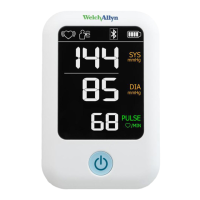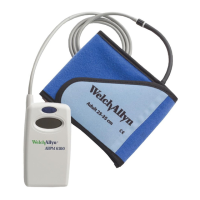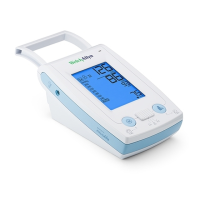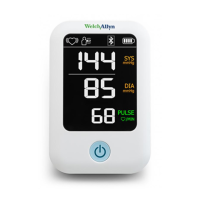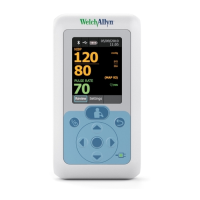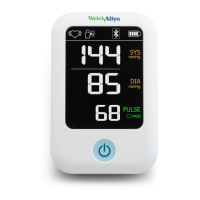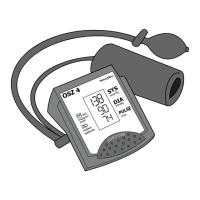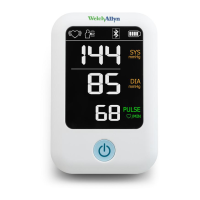
Do you have a question about the Welch Allyn Home and is the answer not in the manual?
| Measurement Method | Oscillometric |
|---|---|
| Display Type | LCD |
| Connectivity | Bluetooth |
| Irregular Heartbeat Detection | Yes |
| User Profiles | 2 |
| Pressure Range | 0-299 mmHg |
| Device Type | Upper Arm Blood Pressure Monitor |
| Memory Capacity | 99 readings |
| Average Reading | Yes |
| Pulse Rate Range | 40-180 bpm |
Indicated for adult home use, featuring SureBP for faster readings and Bluetooth for data management.
Contraindicated for individuals with pacemakers/defibrillators; not a diagnostic device.
Explains warning, caution, and power symbols for safe operation and device status.
Illustrates symbols for SureBP, artery marker, range, index edge, and material composition.
Covers symbols for applied part type, serial number, manufacturer, and equipment classification.
Emphasizes the importance of reading and adhering to all warnings and cautions for user safety.
Warns about risks for specific patient groups, self-treatment, and keeping the unit away from children.
Warns against public use, battery burning, and advises on handling measurement discomfort.
Advises against tube kinking, use on damaged skin, battery contact, and connecting to other medical equipment.
Warns against servicing during use, using unapproved accessories, and modifying the equipment.
Lists the items included in the device box: monitor, cuff, batteries, and manual.
Details the front panel components: cuff, air tube, connector, and power button.
Describes the rear panel components: direct current power connection and battery compartment.
Explains powering the monitor via AA batteries or an approved AC adapter.
Details information shown on the LCD: BP, pulse, alerts, connectivity, and battery status.
Describes symbols for BP readings, pulse rate, irregular heartbeat, and battery indicators.
Explains symbols for Bluetooth status, motion alerts, and out-of-range readings (HI/LO).
Patient as operator, measurement process, data transfer, and necessary components.
Provides instructions and warnings for inserting, replacing, and disposing of batteries.
Instructions for locating and connecting the blood pressure air tube to the monitor.
Steps to pair the monitor with smartphones/tablets for data transfer using Bluetooth 4.0.
Guides on proper cuff placement on the upper arm for optimal measurement accuracy.
Details on preparing oneself, positioning the cuff, and initiating the measurement process.
Instructions for recording results manually or electronically and notes on consistent measurement conditions.
Procedure for safely disconnecting the air tube from the monitor for storage.
Defines systolic pressure, diastolic pressure, and pulse rate for user understanding.
Explains daily variations in blood pressure due to lifestyle, emotions, and medical factors.
Lists factors that cause inaccurate readings and factors that promote accurate measurements.
Provides instructions for cleaning and maintaining the monitor and cuff for optimal performance.
Guide for resolving technical issues like 'No power' or 'Low batteries' using provided solutions.
Details solutions for error codes like E01, E03, E10, and E11 related to cuff security and motion.
Explains high (HI) and low (LO) reading alarms and recommended actions.
Lists key specifications including power, display, measurement range, and accuracy.
Details radio compliance, software version, and external dimensions of the device.
Information on FCC rules for compliance and preventing harmful radio interference.
States compliance with FCC RF exposure limits for uncontrolled environments.
Details the two-year warranty, period start, and conditions that void the warranty.
Enumerates approved accessories such as D-Ring cuffs and the AC adapter for the monitor.
Guidance on electromagnetic emissions and cautions regarding wireless communication equipment.
Details immunity tests for ESD, fast transient/burst, and surge, along with compliance levels.
Covers immunity to voltage dips, interruptions, and power frequency magnetic fields.
Details conducted RF immunity and recommended separation distances for RF communications equipment.
Covers radiated RF immunity and provides formulas for calculating separation distances.
Table providing recommended separation distances for RF transmitters based on output power.
